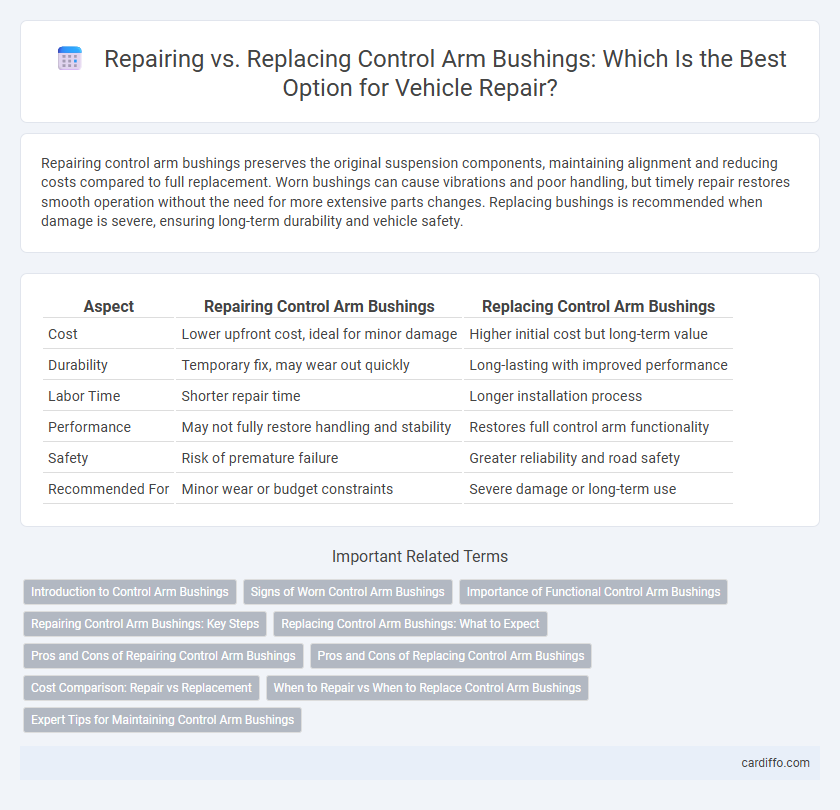Repairing control arm bushings preserves the original suspension components, maintaining alignment and reducing costs compared to full replacement. Worn bushings can cause vibrations and poor handling, but timely repair restores smooth operation without the need for more extensive parts changes. Replacing bushings is recommended when damage is severe, ensuring long-term durability and vehicle safety.
Table of Comparison
| Aspect | Repairing Control Arm Bushings | Replacing Control Arm Bushings |
|---|---|---|
| Cost | Lower upfront cost, ideal for minor damage | Higher initial cost but long-term value |
| Durability | Temporary fix, may wear out quickly | Long-lasting with improved performance |
| Labor Time | Shorter repair time | Longer installation process |
| Performance | May not fully restore handling and stability | Restores full control arm functionality |
| Safety | Risk of premature failure | Greater reliability and road safety |
| Recommended For | Minor wear or budget constraints | Severe damage or long-term use |
Introduction to Control Arm Bushings
Control arm bushings are essential components that connect the suspension control arms to the vehicle's frame, absorbing shocks and reducing vibrations for a smoother ride. Over time, these rubber or polyurethane bushings wear out due to stress and environmental factors, leading to compromised handling and increased road noise. Repairing control arm bushings restores suspension alignment and performance, while replacing them is often necessary when damage is extensive or the bushings are severely deteriorated.
Signs of Worn Control Arm Bushings
Worn control arm bushings cause clunking noises, uneven tire wear, and poor vehicle alignment, signaling the need for immediate attention. Vibrations felt in the steering wheel and loose handling often indicate deteriorated bushings that compromise suspension performance. Identifying these symptoms early can help decide whether to repair or replace control arm bushings for safer driving and prolonged vehicle life.
Importance of Functional Control Arm Bushings
Functional control arm bushings are crucial for maintaining vehicle stability, steering precision, and reducing vibrations, directly affecting safety and ride comfort. Choosing to repair rather than replace them can save costs but risks compromised performance if the damage is extensive. Ensuring high-quality, intact bushings preserves suspension integrity and prevents premature wear on other components.
Repairing Control Arm Bushings: Key Steps
Repairing control arm bushings involves cleaning the damaged area, removing the old bushing, and pressing in a new one with specialized tools to ensure proper alignment. Proper lubrication and inspection of the control arm assembly are essential steps to prevent premature wear and maintain vehicle stability. Timely bushing repair enhances suspension performance and avoids the higher cost of full control arm replacement.
Replacing Control Arm Bushings: What to Expect
Replacing control arm bushings typically involves removing the control arm from the vehicle, pressing out the old bushings, and installing new ones using specialized tools or taking the assembly to a professional shop. This process restores proper suspension alignment, reduces noise, vibration, and harshness, and enhances vehicle handling and safety. Expect a service time ranging from one to three hours, depending on the vehicle model and the condition of other suspension components.
Pros and Cons of Repairing Control Arm Bushings
Repairing control arm bushings preserves original suspension geometry and can be cost-effective compared to full replacement, especially when damage is minimal. This approach reduces downtime and avoids the complexity of disassembling the entire control arm, but may not fully restore the bushing's durability or performance. Frequent repairs can lead to compromised handling and premature wear, making replacement a more reliable long-term solution in severe cases.
Pros and Cons of Replacing Control Arm Bushings
Replacing control arm bushings restores vehicle stability and improves steering responsiveness by eliminating worn-out components. New bushings often last longer and enhance ride quality, but the replacement cost is higher compared to simple repair and may require professional installation to ensure proper alignment. Choosing to replace bushings can prevent premature tire wear and suspension damage, offering a more reliable long-term solution despite upfront expenses.
Cost Comparison: Repair vs Replacement
Repairing control arm bushings typically costs between $50 and $150 for parts and labor, offering a budget-friendly option when damage is minimal. Replacing bushings or the entire control arm can range from $200 to $600, factoring in higher parts costs and more intensive labor. Choosing repair over replacement depends on the extent of wear, with repairs providing short-term savings and replacements ensuring longer-lasting performance.
When to Repair vs When to Replace Control Arm Bushings
Control arm bushings should be repaired when minor wear or superficial damage is present, preserving vehicle alignment and ride comfort at a lower cost. Replacement becomes necessary when bushings show significant cracks, severe deterioration, or cause noticeable handling issues, ensuring safety and preventing further suspension damage. Timely assessment using visual inspection and symptom evaluation is crucial for determining the appropriate action between repair and replacement.
Expert Tips for Maintaining Control Arm Bushings
Control arm bushings play a crucial role in vehicle suspension, ensuring smooth handling and reducing road noise. Expert tips recommend inspecting bushings regularly for cracks or excessive wear, as timely repair can extend their lifespan and prevent costly replacements. Using high-quality polyurethane bushings enhances durability and performance compared to standard rubber options.
Repairing vs replacing control arm bushings Infographic

 cardiffo.com
cardiffo.com